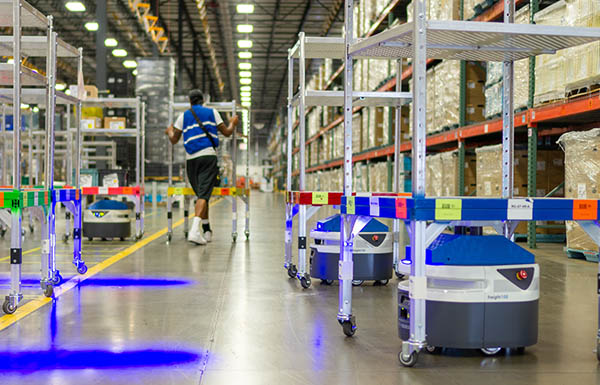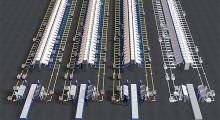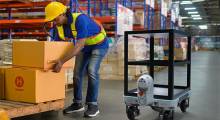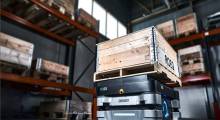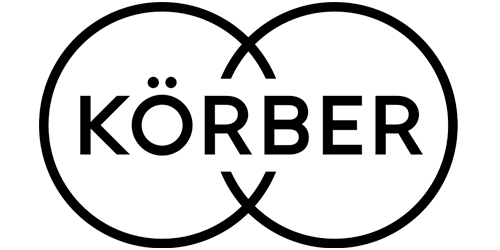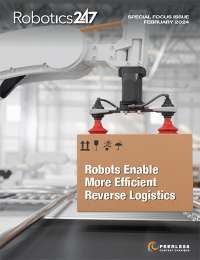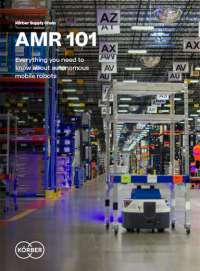More automation doesn’t necessarily mean better automation. That’s why a deployment with an impressive number of autonomous mobile robots, or AMRs, in a mobile robot fleet isn’t necessarily more effective than one with just a handful.
While it’s common for mobile robot deployments to start small and get bigger, success with AMRs takes more than growing the fleet. You need to consider how quickly and easily you can add more automation and people into a robotic-enabled workflow to handle spikes in demand, as well as software capabilities and the ability to integrate with other systems.
Mobile robots come in various form factors and payload capacities. Some larger AMRs are designed to transport heavier loads, while assistive-pick AMRs work in concert with human workers, and goods-to-person (GTP) systems bring goods to picker workstations.
Warehouse labor shortage encourages automation
While AMRs aren’t mainstream yet, warehouse operators are struggling to find enough hourly workers and are turning to automation for help.
“The challenge is that there aren’t enough people to fill those roles any more, or they don’t want them, all while the cost of labor is increasing,” said John Santagate, vice president of robotics and voice at Körber Supply Chain, a provider of supply chain execution software. “As a result, organizations are looking at how to reduce the increasing costs and also the risk associated with not being able to have enough labor, so they are looking at mobile robots.”
AMR solutions are often designed to work alongside people, reducing the non-value-added walking involved under traditional methods, especially when software wasn’t used to optimize pick paths.
For example, with assistive-pick robots, the human picker stays in a compact zone, and a succession of AMRs swing by to guide the worker through picks with minimal travel. More ergonomic work and associate satisfaction factor into the mix when assessing what constitutes success.
“We’ve seen incredible results from our customers in terms of productivity and throughput, but also with some of the softer benefits, like improved employee happiness and retention,” said Kaitlin Peterson, senior director of product marketing at AMR provider Locus Robotics. “They are walking less, by more than half, which reduces fatigue, and pushing heavy picking carts, which carries the risk of strains or injury, is eliminated with our solution.”
Scope, then scale mobile robot fleets
There is no ideal size for a mobile robot fleet. For instance, many Locus customers have around 50 Locusbots in their fleets, but some work fine with as few as a dozen. On the other hand, one customer runs 500 robots at a site that has picking on a four-level mezzanine, noted Peterson.
Figuring out how many AMRs are needed for an operation comes down to proper assessment of an operation’s order mix, its existing processes and layout, service levels, and other characteristics, said Santagate.
“We look at their demand volume, their historical demand, we look at SKUs and dimensionality, layout, and configuration of their warehouse, like where would the induct and drop off points to a system be,” he explained.
“All of those nuances impact the level of robotic capacity that’s going to be required and which approaches will support peak volumes,” Santagate added. “You should also consider how to possibly reshape your processes to make better use of a robot-enabled picking environment.”
The throughput improvements with AMRs can be impressive. Integrated Supply Network, an automotive tool and equipment distributor that uses a Körber warehouse management system (WMS) integrated with Locus' robots, improved productivity by 266% in comparison with its previous method.
Most AMR implementations are measured in weeks, not months, said Santagate, while robotics-as-a-service (RaaS) arrangements from AMR vendors offer a way to scale up the hardware needed to handle peaks without upfront capital expense. Another benefit of AMRs is that touchscreen user-interface features on the robots speed up onboarding, he noted.
“You don’t need a week anymore to train someone to do picking—you can train someone in about an hour, which is a critical element in the benefits of robotic-enabled picking,” Santagate said.
Kristi Montgomery, vice president of innovation with Kenco Group, a third-party logistics provider (3PL), agreed that proper solution scoping is a key first step to any automation project, AMRs included. At some of its distribution centers (DCs), Kenco uses Locus AMRs to accelerate each picking, which Montgomery said has increased the lines per hour picked in those DCs from roughly 30 to 40 lines per hour to 120 to 150 lines per hour.
“We were very deliberate about establishing the success metrics prior to the implementation,” she said.
A phased approach to AMRs can be a good idea, added Montgomery, because it’s a learning experience.
“Even in a pilot implementation, you typically aren’t going to learn everything that could possibly happen on the production floor, so it can be good to go about it in a phased approach—to bring in the robots, see how they function, see how people react to them, see how well they integrate to WMS, and see how process might change,” she said.
“Because inevitably, when you add automation, whether it's mobile robotics or large automation projects, your processes might need to change a bit,” said Montgomery. “Then once you have those processes well defined and worked in, then maybe it’s time to bring in other solutions or systems you might want to integrate [AMRs] with.”
Top Notch deploys 6RS Chuck in stages
Top Notch Distributors, a wholesale distributor of architectural door hardware, has rolled out an assistive pick AMR solution from 6 River Systems at multiple sites, learning from each deployment. The mobile robots, which 6 River nicknames “Chucks,” were first deployed in Top Notch’s facility in Carson City, Nev., which allowed the company to validate the technology in a lower-risk environment, said Patrick Houlihan, director of operations for Top Notch.
“Next, we implemented Chucks into our larger St. Charles, Mo., facility, where we saw improvements in the health and safety of our employees, lowered operating costs per order and standardized work processes across our entire network,” he recalled.
“With improved efficiency and productivity in Carson City and St. Charles, we implemented Chucks in our Mansfield, Mass., facility,” Houlihan said. “In comparison to previous methods, we’ve reduced associate training time by 75%, seen a 50% reduction in steps per day, and more than doubled productivity, leading to higher employee satisfaction.”
Working jointly, 6 River and Top Notch determined they could increase throughput by spacing out the order batch waves. At times, Top Notch started to delay inducting orders onto the AMRs by completing inventory replenishment tasks first thing in the morning, which led to greater productivity later in the shift, said Matt Fitzgerald, director of product management at 6 River Systems.
“The time spent in replenishment led to efficiencies in the order picking process, allowing teams to complete picking work two hours earlier, despite the later start,” he said.
Multiple systems require integration
Many end user organizations integrate mobile robot fleets with additional systems to gain efficiencies. Most assistive-pick robots need to communicate with a WMS to obtain order data. Meanwhile other sites implement AMRs with automated conveyors, pack-out lines, or voice systems, especially for picking cases to larger AMRs.
According to Fitzgerald, 6 River Systems’ partner program supports integration with systems such as automatic box builders, autobaggers, and vertical lift modules.
In some cases, AMR solutions might integrate with a manufacturing execution system (MES) or enterprise resource planning (ERP) software. The need to simplify integration of multiple robots with WMSes has given rise to new vendors, including SVT Robotics, whose software Kenco uses to streamline integration of robotics to its WMS.
BMC automates to stay competitive
Bespoke Manufacturing Co. (BMC) has integrated an MES-type system with Fetch AMRs from Zebra Technologies with fixed position scanning. This has allowed the apparel manufacturer to automatically capture detailed data on the movement on work-in-progress materials while automating materials handling and movement, according to J. Kirby Best, president and CEO of BMC.
Phoenix-based BMC worked with Zebra partner S&H Systems to devise the setup, which went live in summer 2022. The integrated mobile robot fleet was aimed at enabling WIP visibility to make better manufacturing decisions.
According to Best, 378 scan points are currently in the process with a few handheld scan devices, but about 95% of the scan points feature fixed-position equipment, also from Zebra. The previous system used conveyors, but Best said AMRs were an attractive alternative for the new site because they could save floor space.
Fixed-position scanning is highly accurate compared with handhelds and also saves production staff time by automating nearly all data collection as WIP materials—garment pieces like sleeves—move through the process on one of 15 AMRs, said Best.
“We were either going to go with a conveyor belt system, or we were going to go with AMRs [for automated transport],” he said. “We went with a conveyor system last time, and when we learned we could free up floor space with AMRs, we went with the mobile robots.”
For Best, BMC takes advantage of the flexibility of AMRs, but its overall intent was to gain visibility into granular, real-time data about where work is to optimally route materials. In some cases, it can reassign workers to different stations using the production management software from iCreateone, which also developed BMCs front-end commerce platform and design collaboration software.
At a strategic level, the overall system allows BMC’s Phoenix operation to be competitive in cost and time with overseas apparel manufacturers by supporting fast, customized production and tapping into the strong base of skilled sewers in the Phoenix area, said Best.
“In the long run, what the overall system is really doing is allowing us to challenge offshore manufacturing with what we think is a better product delivered faster,” he said. “The idea of labor saving didn’t really enter my mind, though there are some efficiencies to the data capture. Primarily, we were interested in what we could do with the information being gathered, to load-balance our operation.”
GreyOrange offers multi-agent orchestration
While many warehouse are just starting to adopt mobile robots, as more companies use AMRs, interoperability is increasing in importance. Businesses will need systems from multiple vendors to work well together, from large AMRs moving pallets to picking and fulfillment systems, as well as GTP robots.
This trend toward heterogenous environments is giving rise to software that can manage mobile robot fleets from a mix of vendors.
“At the core of our software is the ability to work with different resources or ‘agents’ that are available, and that includes people,” said Samay Kohli, CEO at GreyOrange, an AMR provider whose GreyMatter software conducts “multi-agent orchestration.”
“We support multi-agent orchestration with what we call drivers,” he explained. “We have different drivers for different classes of agents, including robot systems with different payloads, for example, or traditional automation hardware, or humans with different job roles or titles. You need software that can orchestrate this whole plethora of agents, and which is flexible and easy to use for a client or integrator.”
In addition to drivers, the software applies artificial intelligence and machine learning as a data science foundation, said Kohli. GreyMatter delays making agent assignments until the last possible minute to consider resource availability and optimize assignments based on current conditions.
“Fundamentally, you can’t have a rigid system, because robots may be charging or otherwise not available. Sometimes, there is heavier traffic in an area, the SKU mix changes, and of course the order pool changes,” he said. “The system will determine what’s the best combination of work and inventory that can be allocated to resources, knowing the current state each resource is in.”
Others also recognize the need to orchestrate different systems. Santagate said Körber has developed its Unified Control System, which integrates and controls different working models, including fixed automation, voice systems, and robots. The trick is to have a standard platform that is easy to work with, he added.
“We get there by enhancements to the software architecture that can manage a heterogeneous or a multi-bot environment and still keep it on a standardized platform,” said Santagate.
About the Author
Follow Robotics 24/7 on Linkedin
About the Author
Follow Robotics 24/7 on Linkedin
Article topics
Email Sign Up

